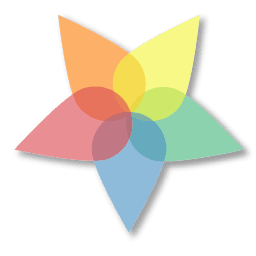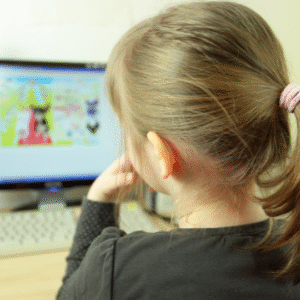Homeschooling has long had great success at producing children who have more skills than their public school peers. The advent of online education seems to make homeschooling more accessible for parents, but are there drawbacks? Do those results still happen when the education is provided online instead of by a parent? What are the pros and cons? How do you decide if this type of education is working for your child?
The Research
I did my best to find good research to site, and the research on online education is a mixed bag. There are studies that indicate that some kids do better online than they do in an in person classroom, while others do not. There is a study that says that in person instruction is better for language arts while math is best done online. However, that was a small scale study at one school. The majority of the research has been done on college students, not K-12. I did not find any studies comparing different ways to homeschool, whether online or by the parent. Complicating this, is that as a homeschooling parent, you can pick and choose and use online courses just for areas you struggle to teach. This means that your child may have better outcomes with that subject by doing it online. But there is a lack of data to help you decide what to do. So, let’s dig into the options so you can make the best choice for your child.
Passive vs. Active Learning
One of the keys to a great homeschool education, is that children get to be active while learning. They physically build the pyramids out of sugar cubes. They have the whole set of math manipulatives to themselves to count, stack and study. They learn on field trips, while playing in the yard, and during their bedtime stories. Much of their learning is active and engaging. “Mom, what is this!” they yell upon finding a new bug. “That’s a praying mantis. See how it is holding its arms? People think it looks like it is praying. Let’s leave it in the garden to eat any bugs that want to eat our plants.” This is organic, active, learning.
When children do the majority of their education online, it is a more passive experience. They watch the videos, listen to the stories, but there is nothing to touch, hold or smell. Often, assignments are completed without a teacher involved, so there is no one to ask questions in the moment. They loose out on the ability to stop what they are doing and just ask about something that interested them. The entire educational experience is much more passive. The child is given information without the joy of interacting with the teacher, peers, or the material.This type of learning actually creates fewer brain connections and the material is often forgotten because the brain didn’t engage with it enough to care about it.
The vast majority of research on child learning, indicates that children learn best through play. Historically, that has been studied as interactive, physical play. These days, children may have opportunities to learn from Apps or other computer based games. In my parenting experience, these are a mixed bag. A child can definitely learn from a fun, interactive computer based game. However, the child has to be ready to learn that material, and it has to be presented in a way that the child understands. More than a few times I have watched a bright toddler “beat” an educational game for older children because he was willing to just keep trying. He wasn’t learning the material, he was just learning to beat the game to get to the next level.
Not All Programs are the Same
In my experience, online programs fall into a few specific categories. One, is a pre-programed, pre-recorded program that children just work through without any teacher interaction. Most assignments are in the program, and kids just watch the videos, read the texts and take the quizzes. This method just checks the box that the child did something educational. It is unlikely the majority of this material will make a lasting impact, or lead to a high quality education, due to the lack of human interaction. Kids doing these programs cannot ask questions, engage more deeply with the material or get clarification if they are confused. To make sure children are not confused or left behind, these programs may move very slowly or make children repeat quiz activities until they make a passing grade.
My mother was a public school teacher for 30 years. She once told me that her educational classes stated that there are three types of children. The first, is a typical child who may need material repeated up to 75 times before they master it. The next group, are the children with learning disabilities who may need even more repetitions and more one on one help to keep up. The last group of kids, are the gifted ones. These children will learn even if you put their desk in the hallway and don’t teach them at all. Which of these children do you have? Which one do you think the online learning platform is designed for? Is it even designed for any of them?
The second kind of online program has a live teacher who is interactive with the class. The teacher may lecture, lead class discussions and grade work. To me, the biggest question with this method is “How big is the class?” Some online programs have small class sizes so teachers get to know your student. In these classes, online programs can have the benefits of a real classroom without the drawbacks. The problems with this method arise when a teacher has a huge number of students. Some online schools sign up live teachers to teach FAR more students than a typical classroom could hold. This reduces the amount of time teachers actually have for questions and the chance the child will get true interaction with the teacher or other students. Too many students just makes this too hard.
Finally, we have the classes that are a combination of the two methods above. This course is usually a mostly self led set of lessons, but with a real teacher grading the work and giving feedback. Many years ago I used a program like this to work on writing with one of my kids. As a single course, it was actually a good fit. My child wasn’t taking feedback from me, so getting it from someone else was valuable. My kid was in high school, so they were mature enough to learn from just reading the instructions and taking the quizzes, followed by writing the assignments. Having a real teacher giving us feedback was definitely better than just having a computer grade their work. I could also read the feedback with my student and discuss their work without the attitude I had been dealing with.
Older Vs Younger Students
To me, the best group to try out online learning is the older middle or high school student, and the worst is elementary students. The younger the student, the more they need the interaction of a real person to teach them. Children want to please their parents and teachers. They are not so likely to want to please the computer and don’t yet have their own educational goals. School is just a chore that has to be completed for many children. They often don’t care if they are learning, just that everyone is happy with them. This means they may just click through assignments without doing them, because they don’t really understand the point. They may also struggle to learn in such a passive way.
Older students are more likely to understand their own why’s for what they are learning. They have goals of graduation, college or jobs. This means they are more likely to put in the effort to learn from an online program. They also have cognitive skills that younger students lack. They are better prepared to be self directed and complete work without the pressures of a more typical learning dynamic. Colleges also often offer courses online, and taking at least one online course in high school can help students be prepared for those classes.
Single Classes vs. All Online
As I mentioned, I have used a few online programs for my kids. A student doing a few courses online is very different than handing over a full year of school work to an online program. If there is an area your student is struggling in, and you don’t feel like the best teacher, an online program can defiantly fill the gap. This especially applies in high school when students need to take a variety of courses to fill their transcript. The most enriching education is going to have the most variety. Combining parent taught courses with ones at a co-op, online classes and self led ones will prepare your student the most for college or work. Knowing how to learn in a wide variety of ways and situations is helpful.
Keeping them Safe
Let me clear one thing up, while I feel a full online program is not going to give your student the deep, well rounded education that homeschooling has the potential to give, there are reasons I would use a complete curriculum online. If your child is unsafe at school due to bullies, allergies, health issues or otherwise, I would choose to homeschool any way I could do it. My fear with online schooling is that too many parents are trusting it instead of trusting themselves to follow quality book or pdf based programs. But if you are working long hours and cannot provide educational time, you need to keep your child safe. I am a firm believer that a safe, healthy child can fill in gaps in their education later. Use the online program to check the box, just know that it has short comings.
Problems for kids with Learning Disabilities and Neurodiversity
The group of children who will struggle the most with online learning, is usually those with learning disabilities or neurodivergent brains. A dyslexic child usually needs one on one instruction to learn to read. Many “Learn to Read” games can be played without gaining understanding of the material. The child just clicks on letters until one works for the game to be happy. This is the same reason that these children may be passed along in school without learning to read. They learn how to work the system instead of how to read.
Children with ADHD may struggle to sit still at a computer to complete online programs. They may also struggle with programs that go too fast or too slowly and don’t provide hands on experiences. While my ADHD children loved to listen to me read them books, they needed to move around the room while I read. If they got so excited they left the room, I could pause to wait on them to run up and down the stairs and come back. Many online programs just aren’t made to let a child roam the room while listening, much less the house. But movement helps the ADHD brain work.
Children with autism often benefit from homeschooling because they can learn through their special interests. If a parent has a child with a love of trains they may do the following activities. Put letters on train cars to build words. They count trains cars. They learn to graph train speeds and sing train based songs. Online programs do not offer this level of speciality that parents can do. Even if your child doesn’t need this level of accommodation, having time to really dig into what interests them is an essential part of an individualized education for them. Spending the day using all of their brain power doing an online program they don’t really care about isn’t going to help them develop their deeper interests.
What To Do
If you must use an online program for homeschooling, screen it carefully. Check if it has live classes and teachers or not. Ask around about how much time it usually takes to do each day. Kindergarten children should really be able to do their whole school day in less than an hour and have plenty of time for play. Consider how your child learns best. Would they do best with an all in one program, or do you need to source each subject separately?
I strongly recommend you plan to check your child’s work frequently. Be sure their online assignments are getting done and they understand them. A common mistake (even I have made it) is assuming just because your child went to the computer, they were doing work and learning. In some of those programs, kids can repeat the same lesson over and over, trying to get a perfect score. They may not be learning as much as you thought they would.
Be sure your online program allows students to have time to take field trips and do other things than online schooling, if you want the depth of a homeschool education. The difference between a standard education and an amazing one is what you do beyond the curriculums and textbooks/screens. Make time for family games, audiobooks you discuss, and field trips to interesting places. Even if you can’t do those things as often as you would like, be sure they are part of the plan!









0 Comments